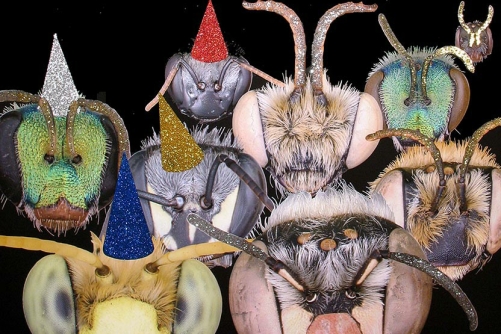
The exhibition, ‘Every third mouthful’, created by the international partnership of Peter Chatwin and Pamela Martin, shows the importance of bees and other pollinators in sustaining our food supply and is open until Thursday 14 September.
Chatwin: Martin formed an art partnership in 1981 to research, create and exhibit artwork in galleries and museums both nationally and internationally, and they have their work in public and private collections worldwide.
This exhibition of prints and drawings highlights the importance of solitary indigenous bees and their role in pollination. The work has evolved from scientific collaboration with leading entomologists worldwide and will showcase some of the extraordinary imagery of insects using close-up microscopes to capture the beauty and intricacy of their features. The series of prints, ‘in the field’ and ‘bee wrangling’ reflect the detailed field-work, methods and language used in researching bee populations.
The large wall panels are constructed from layers of dyed wood veneer, which are worked to reveal strata of colour and texture. Richly coloured text and images indicate a celebration of the natural world. The monochrome, reversed panels reveal the potential result of damage to our fragile environment: we see ‘Superbee’ positioned against the threat of a potential ‘Sixth mass extinction’.
Also on display are some examples from ‘Every last mouthful’, an illuminated manuscript, which illustrates the decline of all pollinators, especially bees. The manuscript amalgamates handwritten script, graffiti and drawing, reflecting artists Chatwin: Martin’s 14-year international collaborative art/science field and laboratory research on three continents with three leading entomologists.
Most recently the project has expanded to include research with conservationists, scientists, economists, ecologists, and historians, and recognises their dedication in striving to provide innovative and radical solutions as to how species and habitat loss can be reversed in the face of total inertia from the international political community.
Peter Chatwin and Pamela Martin explained: “They convey our passion for the preservation of biodiversity and endangered species at a time when it is estimated that, worldwide, we are losing 150 of all species per day.
“Our research has specifically concentrated on solitary bees that comprise 75 per cent of all bee species and are a true barometer of habitat health and biodiversity. They are excellent pollinators and sustain terrestrial landscapes. Worldwide, they are in decline due to human activity, and as a consequence our food supply is under threat.”
Nick Wray, Curator of the Botanic Garden, added: “This worrying trend is increasing. The exhibition highlights the role of these tiny, but important insects play in pollinating our food crops and wild flowers. The illustrations and photographs are fantastic and I know will be enjoyed by visitors who can see some of these insects featured visiting flowers in the Botanic Garden.”
Botanic Garden summer exhibition:’Every third mouthful’ until Thursday 14 September – 10 am to 4.30 pm, Bradley Room, University of Bristol Botanic Garden, The Holmes, Stoke Park Road, Bristol BS9 1JG.
Admission: Entry is free with garden entrance. Admission is £5.50 (Gift Aid payment)* or £5.00 (non – Gift Aid payment); free to University staff and retired staff, Friends of the Botanic Garden, students and children under 18.
Please Note, adult admission is £6 at the Bee and Pollination Festival on 2 and 3 September 2017.
Further information
About the Botanic Garden
The Botanic Garden has a strong evolutionary theme and cultivates over 4,500 plant species forming four core collections that illustrate plant evolution, plants from Mediterranean climates, useful plants and rare and threatened native plants to the Bristol area.
Star attractions include an amazing dell demonstrating the evolution of land plants including the dinosaurs’ favourite plants: ginkgos, cycads, tree ferns, monkey puzzles and the Wollemi Pine. Other delights include the Chinese and Western herb gardens and an inspiring display of plants illustrating floral diversity.
Opening times
Until the end of October the Garden is open from 10 am until 4.30 pm for seven days a week including bank holidays.
Admission is £5.50 (Gift Aid payment)* or £5.00 (non – Gift Aid payment); free to University staff and retired staff, Friends of the Botanic Garden, students and children under 18.
Please Note, adult admission is £6 at the Bee and Pollination Festival on 2 and 3 September 2017.
*The adult gate entry fee of £5.50 includes a 50p voluntary donation which UK taxpayers’ can pay, allowing the Botanic Garden to benefit from a 25 per cent refund of tax from the government on each adult ticket
Dogs (except registered disability assistance dogs) are not permitted in the Botanic Garden.
The garden is largely accessible for wheelchairs and mobility scooters with a designated path leading around the garden and glasshouses. Disabled toilet facilities are available on site.
Pre-booked guided tours of the garden for groups of ten upwards are available seven days a week. Please contact the garden for further information. There is a charge for the guide.
Directions to the Botanic Garden
From the city centre go to the top of Whiteladies Road, at the junction and traffic lights go straight ahead across Durdham Down towards Stoke Bishop. At the traffic lights go straight ahead and take the first turning on the right into Stoke Park Road, The Botanic Garden at the Holmes is 150 metres on the right.
Members of the public wishing to support the work of the Botanic Garden should join the Friends of the Garden. For more information go to the Friends of the Botanic Garden or write to Susan Redfern, The Membership Secretary, 24 Dublin Crescent, Henleaze, Bristol BS9 4NA.










